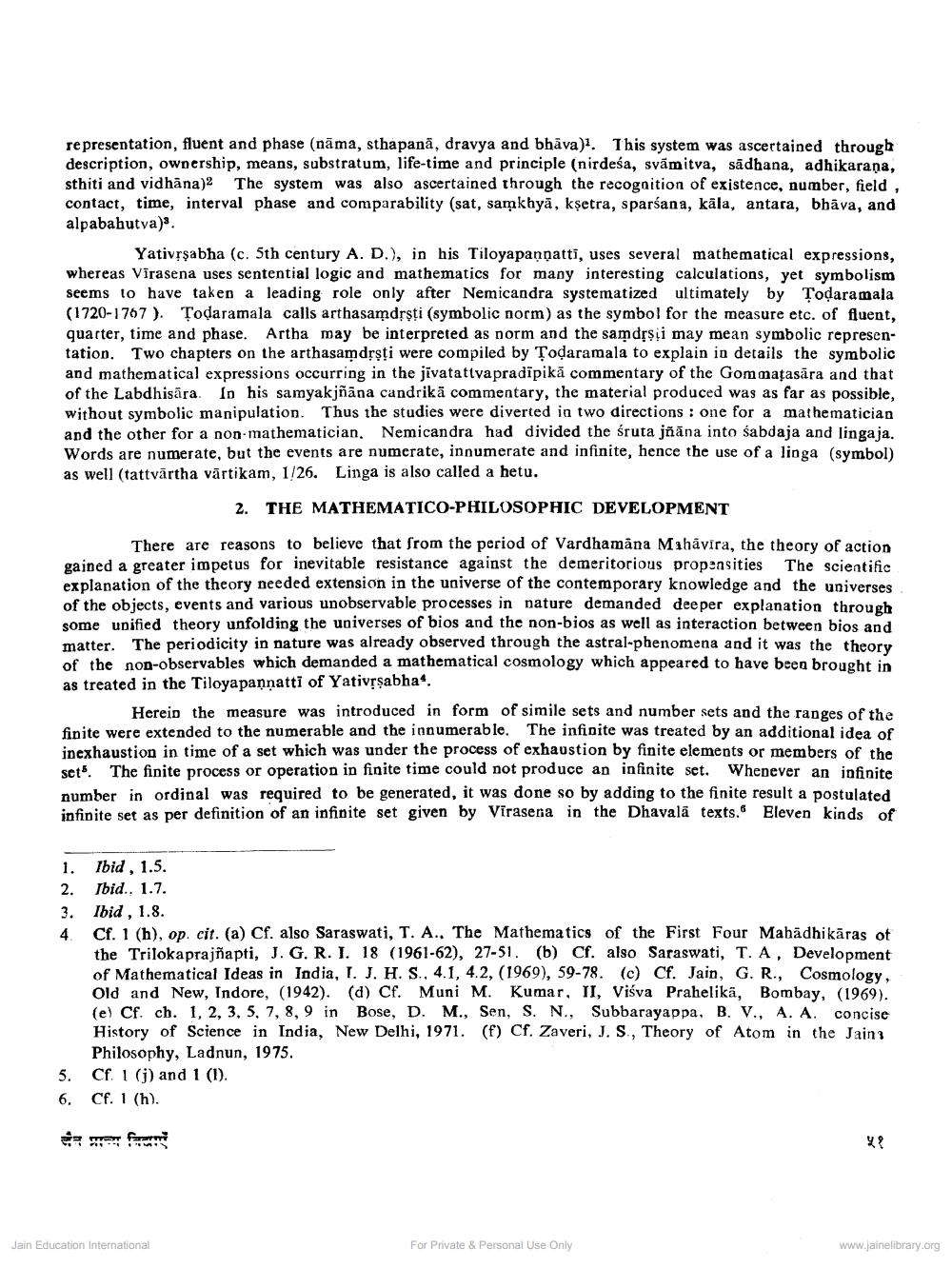Book Title: Jaina Ulterior Motive of Mathematical Philosophy Author(s): L C Jain, C K Jain Publisher: Z_Deshbhushanji_Maharaj_Abhinandan_Granth_012045.pdf View full book textPage 3
________________ representation, fluent and phase (näma, sthapanā, dravya and bhāva)'. This system was ascertained through description, ownership, means, substratum, life-time and principle (nirdeśa, svāmitva, sādhana, adhikarana, sthiti and vidhāna)2 The system was also ascertained through the recognition of existence, number, field, contact, time, interval phase and comparability (sat, samkhyā, kşetra, sparsana, kāla, antara, bhāva, and alpabahutva) Yativrşabha (c. 5th century A. D.), in his Tiloyapannatti, uses several mathematical expressions, whereas Vīrasena uses sentential logic and mathematics for many interesting calculations, yet symbolism seems to have taken a leading role only after Nemicandra systematized ultimately by Todaramala (1720-1767). Todaramala calls arthasamdrști (symbolic norm) as the symbol for the measure etc. of fluent, quarter, time and phase. Artha may be interpreted as norm and the samdrsii may mean symbolic representation. Two chapters on the arthasamdrsti were compiled by Todaramala to explain in details the symbolic and mathematical expressions occurring in the jīvatattvapradipikā commentary of the Gommațasāra and that of the Labdhisāra lo his samyakjñāna candrikä сommentary, the material produced was as far as possible, without symbolic manipulation. Thus the studies were diverted in two directions : one for a mathematician and the other for a non-mathematician. Nemicandra had divided the śruta jñāna into sabdaja and lingaja. Words are numerate, but the events are numerate, innumerate and infinite, hence the use of a linga (symbol) as well (tattvärtha vārtikam, 1/26. Linga is also called a hetu. 2. THE MATHEMATICO-PHILOSOPHIC DEVELOPMENT There are reasons to believe that from the period of Vardhamana Mahavira, the theory of action gained a greater impetus for inevitable resistance against the demeritorious propensities The scientific explanation of the theory needed extension in the universe of the contemporary knowledge and the universes of the objects, events and various unobservable processes in nature demanded deeper explanation through some unified theory unfolding the universes of bios and the non-bios as well as interaction between bios and matter. The periodicity in nature was already observed through the astral phenomena and it was the theory of the non-observables which demanded a mathematical cosmology which appeared to have been brought in as treated in the Tiloyapannatti of Yativrsabha. Herein the measure was introduced in form of simile sets and number sets and the ranges of the finite were extended to the numerable and the innumerable. The infinite was treated by an additional idea of inexhaustion in time of a set which was under the process of exhaustion by finite elements or members of the sets. The finite process or operation in finite time could not produce an infinite set. Whenever an infinite number in ordinal was required to be generated, it was done so by adding to the finite result a postulated infinite set as per definition of an infinite set given by Virasena in the Dhavalā texts. Eleven kinds of 1. 2. 3. J. G. R:1, .H. S.. 4.1, 4.2, ("Kumar. 11, Višva! Ibid, 1.5. Ibid., 1.7. Ibid , 1.8. Cf. 1 (h), op. cit. (a) Cf. also Saraswati, T. A., The Mathematics of the First Four Mahadhikäras ot the Trilokaprajñapti, J. G. R. I. 18 (1961-62), 27-51. (b) Cf. also Saraswati, T.A, Development of Mathematical Ideas in India, I. J. H. S., 4.1, 4.2, (1969), 59-78. (c) Cf. Jain, G. R., Cosmology. Old and New, Indore, (1942). (d) Cf. Muni M. Kumar, II, Viśva Prahelika, Bombay, (1969). (e) Cf. ch. 1, 2, 3, 5, 7, 8, 9 in Bose, D. M., Sen, S.N., Subbarayappa, B. V., A. A. concise History of Science in India, New Delhi, 1971. (f) Cf. Zaveri, J. S, Theory of Atom in the Jain; Philosophy, Ladnun, 1975. Cf. 1 (j) and 1 (1). Cf. 1 (h). 5. 6. fam Jain Education International For Private & Personal Use Only www.jainelibrary.orgPage Navigation
1 2 3 4 5 6 7 8 9 10 11
